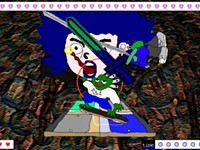[
{
"name": "500x250 Ad",
"insertPoint": "5",
"component": "15667920",
"parentWrapperClass": "",
"requiredCountToDisplay": "1"
}
]
As a gamer, and someone who works in media, I am often posed with having to defend video games. I get the usual FAQ: “Do you think video games cause violence?” Or I have to dispel claims that video games only exist to serve misogynist male fantasies. And then there’s my favorite: “Would you consider games art?” But this kind of criticism and controversy has always impacted new media and forms of artistic expression, including novels in the 19th century and comic books and films in the 20th century.
Video games have already had a massive impact on 21st century culture, and this fact is celebrated in “A History of Video Games in 64 Objects,” a new book produced by The Strong Museum of Play.
I’ve read a lot of books on video games that present and preserve the medium’s relevance while confronting criticism leveled at gaming, but none have truly captured its growth and impact historically or culturally as eloquently as The Strong’s book. Inspired by the British Museum’s “A History of the World in 100 Objects,” the work offers a glimpse into the history of video games using 64 objects (a common number in video game history, i.e. the Commodore 64 computer, and the Nintendo 64 gaming console) from the first electromechanical pinball machine (1947) to “Pokémon Go” (2016), and beyond.
Since 2006 The Strong Museum of Play has been expanding its collection and emphasis on video games’ historic and future impact on play, and the museum in 2015 founded The World Video Game Hall of Fame. “A History of Video Games in 64 Objects” is a demonstration of the museum’s past ten years of exhaustive collecting, preserving, and interpreting the history of video games — The Strong’s collection has more than 60,000 games and related artifacts and hundreds of thousands of archival materials documenting the growth of electronic gaming over the last half century.
The book begins with the 1947 pinball machine “Humpty Dumpty,” the first machine to feature electromechanical flippers and inject skill into a what was formerly a game of chance. Moving forward from 1947 to 2017, each chapter features an item that The Strong considers to be of historic relevance in developing video games. Each item is explored in terms of its origins and the role it played in the industry, the minds behind it, and why it matters. All of which is engaging and told concisely thanks to exceptional writing, and is supplemented by images and subtexts interjecting controversies, misconceptions, and views from the media.
Despite its textbook-like size and presentation, the 340-page book should be easy for non-gamers to digest while not patronizing enthusiasts. I found it hard to put down, enthralled by anecdotes and trivia that I wanted to run out and share. These included the story of Steve Jobs’s role in helping create the game “Breakout” (which, like most of his acclaimed inventions, was actually engineered by friend and underrated partner Steve Wozniak). Or the changing of Pac-Man’s name from its original Japanese title Puckman (out of fear of clever American vandalism), to the earliest account of violence in video games in 1976’s “Death Race.”
“A History of Video Games in 64 Objects” not only best represents the importance of video games in contemporary culture, it also demonstrates just how young the medium is, and that even still, we can only begin to anticipate what gaming will do or accomplish in the future.
Video games are constantly at the root of controversy in their relationship to violence and its potential harmful influence to players — the World Health Organization (WHO) even listed Gaming Disorder under its International Classifications of Diseases early this year. WHO categorizes gaming disorder based on when video games takes precedence over daily activities, dominating the whole life of a person, including the neglect of friends and family members, physical activity, and proper nutrition. WHO also emphasizes that gaming disorder is not equivalent to gaming behavior, and that assessment can take up to 12 months to indicate whether or not an individual has a gaming disorder.
A study conducted by the US Secret Service found no correlation between video games and school shootings, and the American Psychological Association’s Media Psychology division urges that there’s no supporting evidence that video games have a negative impact on the player. In fact, according to research from the Southern Economic Journal in 2016, video games are tied to a decrease in actual violence. Most of these opposing accusations are leveled at games such as “Call of Duty” and “Grand Theft Auto” — two of the most widely popular and culturally infamous titles in contemporary gaming — as examples of “harmful” games. But this completely disregards the broadness of the medium. There are hundreds of other games released each year, and the history of gaming dates back to 1947.
“A History of Video Games in 64 Objects” is a definitive staple among works that present the video game medium as genuinely culturally important, and I place this book alongside Jason Schreier’s “Blood, Sweat, and Pixels” and Tom Bissell’s “Extra Lives” — two books that I encourage enthusiasts and non-gamers alike to read.
Video games have already had a massive impact on 21st century culture, and this fact is celebrated in “A History of Video Games in 64 Objects,” a new book produced by The Strong Museum of Play.
I’ve read a lot of books on video games that present and preserve the medium’s relevance while confronting criticism leveled at gaming, but none have truly captured its growth and impact historically or culturally as eloquently as The Strong’s book. Inspired by the British Museum’s “A History of the World in 100 Objects,” the work offers a glimpse into the history of video games using 64 objects (a common number in video game history, i.e. the Commodore 64 computer, and the Nintendo 64 gaming console) from the first electromechanical pinball machine (1947) to “Pokémon Go” (2016), and beyond.
Since 2006 The Strong Museum of Play has been expanding its collection and emphasis on video games’ historic and future impact on play, and the museum in 2015 founded The World Video Game Hall of Fame. “A History of Video Games in 64 Objects” is a demonstration of the museum’s past ten years of exhaustive collecting, preserving, and interpreting the history of video games — The Strong’s collection has more than 60,000 games and related artifacts and hundreds of thousands of archival materials documenting the growth of electronic gaming over the last half century.
The book begins with the 1947 pinball machine “Humpty Dumpty,” the first machine to feature electromechanical flippers and inject skill into a what was formerly a game of chance. Moving forward from 1947 to 2017, each chapter features an item that The Strong considers to be of historic relevance in developing video games. Each item is explored in terms of its origins and the role it played in the industry, the minds behind it, and why it matters. All of which is engaging and told concisely thanks to exceptional writing, and is supplemented by images and subtexts interjecting controversies, misconceptions, and views from the media.
Despite its textbook-like size and presentation, the 340-page book should be easy for non-gamers to digest while not patronizing enthusiasts. I found it hard to put down, enthralled by anecdotes and trivia that I wanted to run out and share. These included the story of Steve Jobs’s role in helping create the game “Breakout” (which, like most of his acclaimed inventions, was actually engineered by friend and underrated partner Steve Wozniak). Or the changing of Pac-Man’s name from its original Japanese title Puckman (out of fear of clever American vandalism), to the earliest account of violence in video games in 1976’s “Death Race.”
“A History of Video Games in 64 Objects” not only best represents the importance of video games in contemporary culture, it also demonstrates just how young the medium is, and that even still, we can only begin to anticipate what gaming will do or accomplish in the future.
Video games are constantly at the root of controversy in their relationship to violence and its potential harmful influence to players — the World Health Organization (WHO) even listed Gaming Disorder under its International Classifications of Diseases early this year. WHO categorizes gaming disorder based on when video games takes precedence over daily activities, dominating the whole life of a person, including the neglect of friends and family members, physical activity, and proper nutrition. WHO also emphasizes that gaming disorder is not equivalent to gaming behavior, and that assessment can take up to 12 months to indicate whether or not an individual has a gaming disorder.
A study conducted by the US Secret Service found no correlation between video games and school shootings, and the American Psychological Association’s Media Psychology division urges that there’s no supporting evidence that video games have a negative impact on the player. In fact, according to research from the Southern Economic Journal in 2016, video games are tied to a decrease in actual violence. Most of these opposing accusations are leveled at games such as “Call of Duty” and “Grand Theft Auto” — two of the most widely popular and culturally infamous titles in contemporary gaming — as examples of “harmful” games. But this completely disregards the broadness of the medium. There are hundreds of other games released each year, and the history of gaming dates back to 1947.
“A History of Video Games in 64 Objects” is a definitive staple among works that present the video game medium as genuinely culturally important, and I place this book alongside Jason Schreier’s “Blood, Sweat, and Pixels” and Tom Bissell’s “Extra Lives” — two books that I encourage enthusiasts and non-gamers alike to read.
Latest in Culture
More by Kurt Indovina
-

SPECIAL EVENT: Flower City Comic Con
Jun 6, 2018 -

Andrew W.K. goes over the top to see the other side
May 9, 2018 -

Bridging mental health awareness with Free Comic Book Day
May 4, 2018 - More »



